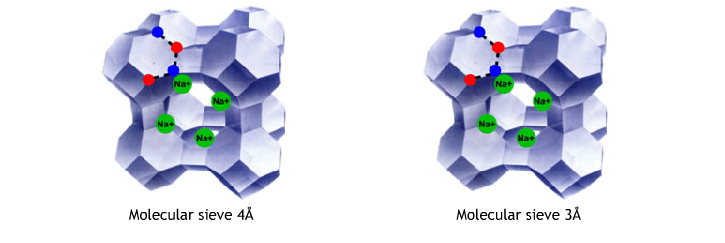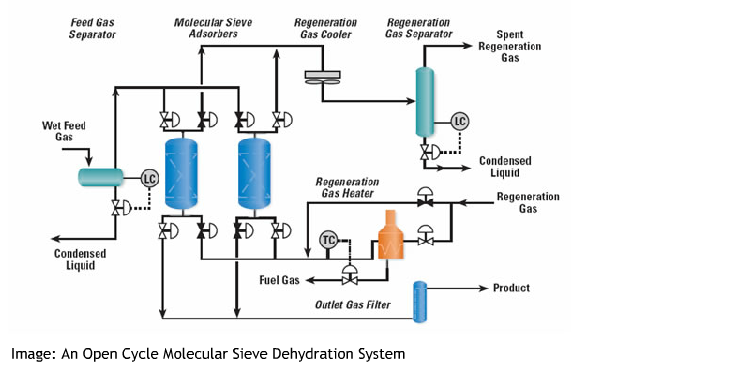Molecular Sieve is crystalline metal alumina silicates having a three dimensional interconnecting network of silica and alumina tetrahedral. Natural water of hydration is removed from this network by heating to produce uniform cavities which selectively adsorb molecules of a specific size.
A 4 to 8-mesh sieve is normally used in gas phase applications, while the 8 to 12-mesh type is common in liquid phase applications. The powder forms of the 3A, 4A, 5A and 13X sieves are suitable for specialized applications.
Long known for their drying capacity (even to 90°C), molecular sieves have recently demonstrated utility in synthetic organic procedures, frequently allowing isolation of desired products from condensation reaction that are governed by generally unfavourable equilibria. These synthetic zeolites have been shown to removed water, alcohols (including methanol and ethanol), and HCI form such system as ketamine and enamine synthetics, ester condensation, and the conversation of unsaturated aldehydes to polyenals.
Zettapac – Structure and Properties
Zettapac molecular sieves are crystalline, highly porous materials, which belong to the class of alumina silicate. These crystals are characterised by a three-dimensional pore system, with pores of precisely defined diameter. The corresponding crystallographic structure is formed by tetrahedras of (AlO4) and (SiO4). These tetrahedras are the basic building blocks for various Zettapacs molecular sieves structures, such as Zettapac molecular sieve A and X, the most common commercial adsorbents.

Due to the presence of alumina, Zettapac molecular sieves exhibit a negatively charged framework, which is counter-balanced by positive cations resulting in a strong electrostatic field on the internal surface. These cations can be exchanged to fine -tune the pore size or the adsorption characteristics. For instance, the sodium form of zeolite A has a pore opening of approximately 4 Ångstrom (4 x 10-10 m), called 4A molecular sieve. If the sodium ion is exchanged with the larger potassium ion, the pore opening is reduced to approximately 3 Ångstrom (3A molecular sieve). On ion exchanged with calcium, one calcium ion replaces two sodium ions. Thus, the pore opening increase to approximately 5 Ångstrom (5A molecular sieve). Ion exchange with other cations is sometimes used for particular separation purposes.

The pore opening of the sodium form of zettapac molecular sieve X (13X) is approximately 8 Ångstrom.
The ability to adjust the pores to precisely determined uniform openings allows for molecules smaller than its pore diameter to be adsorbed whilst excluding larger molecules, hence the name “molecular sieve”. The different pore sizes of synthetic Zettapac molecular sieve open up a wide range of possibilities in term of “sieving” molecules of different size or shape form gases and liquids.
Selective Adsorption of Water and Other Polar Substances
The up-take of water or other species in Zettapac molecular sieve is called adsorption and functions on the basic of Physisorption. The main driving force for adsorption is the highly polar surface within the pores. This unique characteristic distinguishes Zettapac molecular sieve form the commercially available absorbents, enabling an extremely high adsorption capacity for water and other polar components event at very low concentrations.
In additional, the pore size plays a significant role, allowing or prohibiting the entrance of molecules to the pore system.
The adsorption on molecular sieves is therefore dependent on the following physical molecular properties:
- Size and Shape: Molecules larger than the pore opening of the molecular sieve cannot be adsorbed, smaller molecules can.
- Molecular Polarity: Molecules with large polarity or polarisability can be adsorbed preferentially under identical conditions.

Activated Alumina Desiccant
Description: White bead, regular in particle size, smooth at surface, with high crushing strength and strong adsorption of moisture, not expanding and cracking after adsorbing water, original shape kept.
Odorless, tasteless, non-toxic, insoluble in water and alcohol.
Application:
Widely used in oxygen making industry, textile industry, for gas drying in electronic industry. Used for air separation, in petroleum and chemical industries as drying and cleaning agent.
Specification:
| Item | Unit | Bead | ||||||
| Diameter | mm | 0.4-1.2 | 2-3 | 3-4 | 3-5 | 4-6 | 5-7 | 6-8 |
| SiO2 | ≥wt% | 0.10 | 0.10 | 0.10 | 0.10 | 0.10 | 0.10 | 0.10 |
| Fe2O3 | ≤wt% | 0.04 | 0.04 | 0.04 | 0.04 | 0.04 | 0.04 | 0.04 |
| Na2O | ≥g/ml | 0.45 | 0.45 | 0.45 | 0.45 | 0.45 | 0.45 | 0.45 |
| L.O.I. | ≤N/Pc | 8 | 8 | 8 | 8 | 8 | 8 | 8 |
| Bulk Density | ≤wt% | 0.75 | 0.75 | 0.75 | 0.75 | 0.75 | 0.75 | 0.75 |
| Surface | ≤wt% | 300 | 300 | 300 | 300 | 300 | 300 | 300 |
| Pore Volume | ≥ml/g | 0.40 | 0.40 | 0.40 | 0.40 | 0.40 | 0.40 | 0.40 |
| Crushing Strength | ≥N/Pc | / | 60 | 100 | 130 | 160 | 180 | 200 |
AI2O3%= (100%- SiO2%- Fe2O3%- Na2O%- L.O.I.)
Molecular Sieve 3A
Description: A kind of potassium-sodium aluminosilicate, with crystal diameter of 3 angstroms (0.3nm).
Application:
In deep desiccation of cracked petroleum gases, unsaturated hydrocarbons (such as ethylene, propylene, butadiene, acetylene).
Used for dehydration of benzene, toluene, xylene and other solvents (methanol, ethanol), and food grade CO2 gas.
Specification:
| Item | Unit | Bead | Pellet | ||
| Diameter | mm | 1.6-2.5 | 3-5 | 1/16′ | 1/8′ |
| Static Water Adsorption | ≥wt% | 20.5 | 20.5 | 20.5 | 20.5 |
| CO2 Adsorption | ≤wt% | 1.5 | 1.5 | 1.0 | 1.0 |
| Bulk Density | ≥g/ml | 0.70 | 0.68 | 0.68 | 0.66 |
| Crushing Strength | ≤N/Pc | 25 | 75 | 30 | 70 |
| Attrition Rate | ≤wt% | 0.1 | 0.1 | 0.4 | 0.4 |
| Package Moisture | ≤wt% | 1.5 | 1.5 | 1.5 | 1.5 |
Molecular Sieve 4A
Description: A kind of sodium aluminosilicate, with crystal diameter of 4 angstroms (0.4nm).
Application:
It is mainly used for desiccation of gases, natural gas, alkane and other organic solvents. Used for refining and purification of gases and liquids, such as argon.
Drying for drug packaging, electronic components, etc.
Specification:
| Item | Unit | Bead | Pellet | ||
| Diameter | mm | 1.6-2.5 | 3-5 | 1/16′ | 1/8′ |
| Static Water Adsorption | ≥wt% | 21.5 | 21.5 | 21.5 | 21.5 |
| Methanol Adsorption | ≤wt% | 14 | 14 | 14 | 14 |
| Bulk Density | ≥g/ml | 0.68 | 0.68 | 0.68 | 0.66 |
| Crushing Strength | ≤N/Pc | 30 | 80 | 30 | 80 |
| Attrition Rate | ≤wt% | 0.1 | 0.1 | 0.4 | 0.4 |
| Package Moisture | ≤wt% | 1.5 | 1.5 | 1.5 | 1.5 |
Molecular Sieve 5A
Description: A kind of calcium-sodium aluminosilicate, with crystal diameter of 5 angstroms (0.5nm).
Application:
For dehydration of nautral gas, CO2, CO, H2S.
For dehydration and purification of air, nitrogen, inert gases and hydrogen in industry
Specification:
| Item | Unit | Bead | Pellet | ||
| Diameter | mm | 1.6-2.5 | 3-5 | 1/16′ | 1/8′ |
| Static Water Adsorption | ≥wt% | 22 | 22 | 22 | 22 |
| N-hexane Adsorption | ≤wt% | 12 | 12 | 12 | 12 |
| Bulk Density | ≥g/ml | 0.68 | 0.68 | 0.68 | 0.66 |
| Crushing Strength | ≤N/Pc | 30 | 80 | 35 | 70 |
| Attrition Rate | ≤wt% | 0.1 | 0.1 | 0.3 | 0.3 |
| Package Moisture | ≤wt% | 1.5 | 1.5 | 1.5 | 1.5 |
Molecular Sieve 13X APG
Description: A kind of sodium X-type aluminosilicate, with crystal diameter of 9 angstroms (0.9nm). It owns the feature of high CO2, adsorption, low regeneration temperature, and long service life.
Application:
Used for general air-drying in industry, decontamination of raw material in air-separating equipment to avoid the frost tower phenomenon.
High H2O and CO2 adsorption capacity.
Specification:
| Item | Unit | Bead | Pellet | |||
| Diameter | mm | 0.5-0.8 | 1.6-2.5 | 3-5 | 1/16′ | 1/8′ |
| Static Water Adsorption | ≥wt% | 27 | 26.5 | 26.5 | 26 | 26 |
| CO2 Adsorption | ≤wt% | 17.5 | 17.5 | 17.5 | 17.5 | 17.5 |
| Bulk Density | ≥g/ml | 0.70 | 0.64 | 0.60 | 0.60 | 0.66 |
| Crushing Strength | ≤N/Pc | / | 25 | 70 | 25 | 65 |
| Attrition Rate | ≤wt% | / | 0.1 | 0.1 | 0.4 | 0.4 |
| Package Moisture | ≤wt% | 1.5 | 1.5 | 1.5 | 2.0 | 2.0 |
